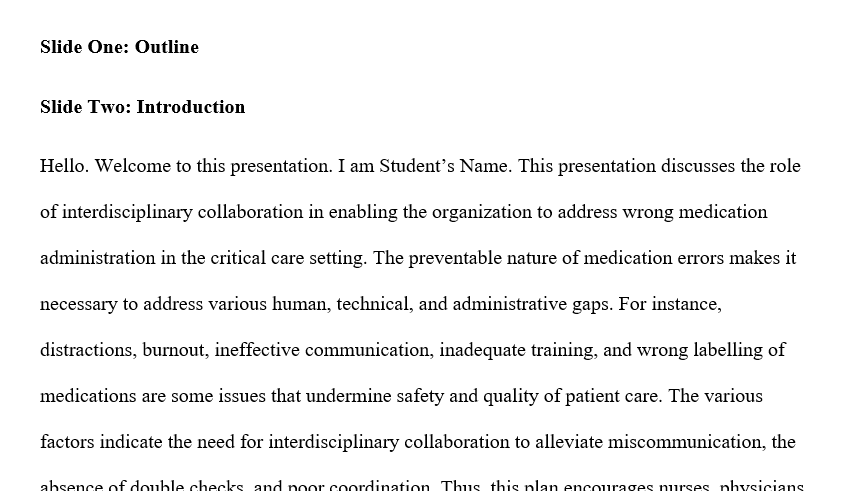NURS-FPX4010_O_Assessment 4-2-Notes.docx
Slide One: Outline
Slide Two: Introduction
Hello. Welcome to this presentation. I am Student’s Name. This presentation discusses the role of interdisciplinary collaboration in enabling the organization to address wrong medication administration in the critical care setting. The preventable nature of medication errors makes it necessary to address various human, technical, and administrative gaps.
For instance, distractions, burnout, ineffective communication, inadequate training, and wrong labelling of medications are some issues that undermine safety and quality of patient care. The various factors indicate the need for interdisciplinary collaboration to alleviate miscommunication, the absence of double checks, and poor coordination. Thus, this plan encourages nurses, physicians, pharmacists, and other relevant parties to coordinate medication administration processes.
Slide Three: Wrong Drugs Administration
Ineffective collaboration between physicians, nurses, and pharmacists that undermine the calls for verification, consistent oversight, and effective communication. Wrong drugs administered to patients increase morbidity and mortality risks, expose organization to declining brand credibility, and increase the cost of health care delivery.
Thus, interdisciplinary processes are necessary to enhance vigilance and trigger collective commitment to verifying medications and ensuring that nurses administer medications to the right patient. Trainings and briefings are necessary to enable individuals to share experiences and evidence on the best ways to improve the quality and safety of patient care.
Slide Four: Collaborative Interdisciplinary Team Approach
Successful prevention of wrong medication administration calls for proactive collaboration between physicians, nurses, and pharmacists. The process makes members of the care team aware about the need for double medication verification, consistent oversight, and effective communication throughout the medication administration (Manias, 2018).
Similarly, interdisciplinary collaborations makes the care team familiar with the risk of increased morbidity and mortality risks, declining brand credibility, and rising cost of health care delivery (Tsegaye et al., 2020). Thus, interdisciplinary processes are necessary to enhance vigilance and trigger collective commitment to verifying medications and ensuring that nurses administer drugs to the right patient.
Slide Five: Interdisciplinary Plan Summary
Effective interdisciplinary collaboration entails alignment between individual and collective aspirations. The process involves supportive relationships and buy-in from leaders and the rest of the workforce. As such, everyone participates in sharing creative solutions on addressing medication administration errors.
The team involved in the interdisciplinary processes includes nurses, physicians, pharmacists, the nurse manager, and an administrator. The group will deliberate on medication administration safety, implications on organization and patients, and sustainable interventions.
Active participation in briefings will give everyone the chance to share experiences on wrong medication administration and risks that increase patient vulnerability to undesirable outcomes.
Slide Six: Applying the PDSA Model to the Plan
Successful outcomes depend on effective leadership and change management. The PDSA cycle provides a systematic framework for encouraging everyone to understand the principles of improvement and facilitate meaningful changes in the critical care setting. The goal is to ensure that everyone engages positively with change (Crowfoot & Prasad, 2017).
First, the team will familiarize with wrong drugs administration and adverse impacts on organization. The PDSA cycle also encourages leaders to share a common vision and details of the beliefs, values, and behaviors that enhance interdisciplinary practices (McGowan & Reid, 2018). The nurse manager explains the need for a comprehensive education to make everyone familiar with personal and professional commitment to optimizing quality and safety outcomes.
The second phase is sharing educational materials such as rounding checklists and watching videos on medication administration practices. The interdisciplinary process will also involve the leader engaging the team on outcomes, barriers, and enablers that produce the intended outcomes. The nurse leader will outline the progress and alignment with the stated objectives.
Slide Seven: Leadership Roles in Preventing Wrong Drug Administration
Leading in a complex care environment requires nurses to acquire essential qualities and traits to enable them achieve the desired collaboration. The right leaders maintain effective communication, trust, shared governance, and task prioritization to enable the team to respond to patients’ demands (Varagona et al., 2017). Advocacy for enhanced communication reinforces the quality of clinical rounds, staff meetings, and other practices help optimize outcomes.
Modelling trust and respect is also necessary to encourage a culture of shared responsibility and accountability (Duffy et al., 2020). Shared governance and autonomy also encourage interprofessional collaboration. Healthcare professionals take advantage of distributed power to share innovative solutions and contribute in decision-making processes.
Thus, effective leaders encourage active involvement in interdisciplinary efforts to make everyone aware of events in the clinical environment and options for improving quality and safety of patient care.
Slide Eight: Collaboration Strategy
The team includes the nurse manager, physicians, nurses, pharmacist, and an administrator. The group plays key roles in medication administration process. Collective efforts reinforce commitment to verifying drug and instructions before administering to a patient. The nurse manager will set the direction for the rest of the team due to knowledge and experiences in frontline issues.
The leader understands adverse outcomes triggered by wrong drugs administration. However, open and honest conversations are necessary to overcome hierarchical barriers. The goal is to create the right environment that encourages everyone to share details of the wrong drug administration and sustainable interventions.
Slide Nine: Resources
| Resource | Description | Cost ($) |
| Internet connectivity | The briefings will include audio and video presentations that require a strong Internet connection. | 100 |
| Drug administration safety checklists | The audience will familiarize with several risks, consequences, and solutions for wrong drug administration. | 100 |
| Medication safety pocket handouts | The audience can utilize the pocket handouts to read insights about safe medication administration across the care continuum. | 100 |
| Consultant | Offer an in-depth perspective of medication administration errors and the impact of interdisciplinary collaboration in intercepting errors. | 1,000 |
| Case scenarios | Review scenarios of organizations that initiated briefings and managed to reduce medication administration errors. | 200 |
| TOTAL | 1,500 |
Successful outcomes depend on the adequacy of human, technical, and administrative resources. The briefings require a laptop, projector, handouts, and case scenarios with details on wrong medication administration, risks, frequency, implications, and solutions.
A consultant is also necessary to bring a wider perspective barriers and enablers of safe drug administration. The duration for the briefings is two and a half hours, which allows the audience to share insights into medication errors and viable solutions.
Slide Ten: Evaluating Outcomes
The objectives capture the need for collective dedication to sharing ideas, skills, and experiences on evidence-based practices for reducing wrong medication administration. The nurse manager models the behaviors, attitudes, and values that enhance collaboration between physicians, nurses, and pharmacists (Clausen et al., 2019).
One prediction is that the team will participate in briefings and educational sessions to share details on risk factors associated with wrong medication administration. Another prediction is that everyone in the team will adopt shared interdisciplinary governance to share evidence on viable and sustainable solutions for reducing medication errors.
The primary consideration is encouraging everyone to embrace a common aspiration to intercept errors and reduce risks such as adverse drug reactions, complications, and premature deaths. Further, there are opportunities to embrace transparency, openness, and honesty when sharing information about medication administration risks.
Slide Eleven: Conclusion
Improving patient outcomes and attaining strategic goals are key considerations for nurses. Nurse leaders should encourage nurse participation to create a shared vision and team goals. The goal is to offer opportunities to share experiences, knowledge, and skills within and outside the health care environment.
The interdisciplinary plan addressed in this assessment includes nurses, physicians, the nurse manager, and pharmacists. The group plays significant roles in optimizing medication administration to achieve the intended quality and safety of patient care. Adopting the Plan-Do-Study-Act (PDSA) model guides the team to share accurate and complete information on efforts to reduce medication errors.
Slide Twelve: References
Clausen, C., Emed, J., Frunchak, V., Purden, M., & Sol Bruno, F. (2019). Toward resilient nurse leaders: The leadership-in-action program in nursing (LEAP-IN). Nursing Leadership, 32(3), 40-56. https://pubmed.ncbi.nlm.nih.gov/31714206/
Crowfoot, D., & Prasad, V. (2017). Using the Plan-Do-Study-Act (PSDA) cycle to make change in general practice. InnovAIT, 10(7), 425-430. https://journals.sagepub.com/doi/abs/10.1177/1755738017704472
Khan, A. (2021). Medication error overview and prevention strategies. American International Journal of Social Science Research, 8(1), 19-24. https://www.cribfb.com/journal/index.php/aijssr/article/view/1313/1030
Kim, P., Shen, J., Angosta, A., Frakes, K., & Li, C. (2018). Errors associated with the rights of medication administration at hospital settings. Journal of Hospital and Healthcare Administration, 1, 1-6. https://pdfs.semanticscholar.org/4fa4/ae1574b8c12944f96be772c3b55b59f18b4d.pdf
Manias, E. (2018). Effects of interdisciplinary collaboration in hospitals on medication errors: An integrative review. Expert Opinion on Drug Safety, 17(3), 259-275. https://pubmed.ncbi.nlm.nih.gov/29303376/
McGowan, M., & Reid, B. (2018). Using the Plan, Do, Study, Act cycle to enhance a patient feedback system for older adults. British Journal of Nursing, 27(16), 936–941. https://pubmed.ncbi.nlm.nih.gov/30187794/
Reeves, S., Pelone, F., Harrison, R., Goldman, J., & Zwarenstein, M. (2017). Interprofessional collaboration to improve professional practice and healthcare outcomes. Cochrane Database of Systematic Reviews, 6(6), 1-47. https://pubmed.ncbi.nlm.nih.gov/28639262/
Tsegaye, D., Alem, G., Tessema, Z., & Alebachew, W. (2020). Medication administration errors and associated factors among nurses. International Journal of General Medicine, 13, 1621-1632. https://www.ncbi.nlm.nih.gov/pmc/articles/PMC7764714/
Udod, S. A., & Racine, L. (2017). Empirical and pragmatic adequacy of grounded theory: Advancing nurse empowerment theory for nurses’ practice. Journal of Clinical Nursing, 26(23-24), 5224-5231. https://pubmed.ncbi.nlm.nih.gov/28543705/
Varagona, L., Nandan, M., Hooks, D., Porter, K. J., Maguire, M. B., Slater-Moody, J. (2017). A model to guide the evolution of a multi-professional group into an interprofessional team. The Journal of Faculty Development, 31(2), 49-56. https://eric.ed.gov/?id=EJ1142348



